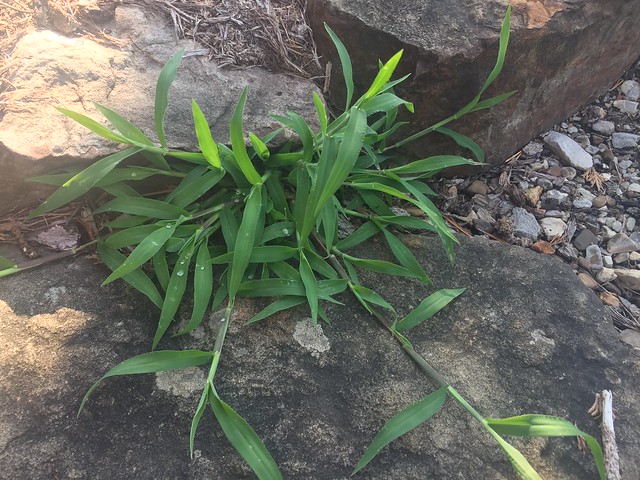Resource Library
Plant of the Week: Digitaria Crabgrass
Lawns are an integral part of most home landscapes, but sometimes the qualities of said lawns are a bit suspect. Ratty, but green, is probably the most common lawn type in the state. For many situations, this ratty appearance is good enough. Were it not for weeds many lawns would be patches of bare soil. For this reason I find it hard to hate crabgrass (Digitaria sp.).
About 250 species of crabgrass are described from mostly tropical and semitropical habitats around the world. They may be annual or perennial in nature, but the two main crabgrasses we encounter in Arkansas, hairy crabgrass (D. sanguinalis) and smooth crabgrass (D. ischaemum), are both annuals. Both are escaped weeds originally from Europe that are now found virtually worldwide in disturbed ground and thin patches of our lawns.
Crabgrass seeds begin germination in mid-spring when soil temperatures reach 58˚F and continue through most of the growing season if there is enough moisture. Seedlings grow fast, forming an eighteen inch tall and wide sprawling clump bearing clusters of finger like awns (hence the Latin name) at the end of the branches. The two species of crabgrass commonly encountered in lawns are very similar, with the presence or absence of hairs on the leaf sheath being the main difference.
Like many common weeds, crabgrass was first introduced by farmers as a field crop. It grows quickly and makes a nutritious, high protein forage. The U of A Cooperative Extension Service has a fact sheet, “Crabgrass for Forage” that recommends improved cultivars, seeding rates and gives all the details on how to grow crabgrass down on the farm. But most of us see crabgrass as a weed in our manicured lawns.
Crabgrass is a warm season grass, and as such relies on the highly efficient C4 method of photosynthesis. Cool season grasses, such as fescue, are C3 plants that prefer cooler temperatures and are inherently less efficient in the way they photosynthesize. The efficiency of this kind of photosynthesis relies on an enzyme that captures carbon dioxide at the epidermis of the plant and transports it as a 4-carbon compound (oxaloacetic acid) to the inner part of the plant – away from the energy robbing free oxygen molecules - where normal photosynthesis occurs.
The optimum temperature for photosynthesis for C3 plants is 75˚F or below whereas C4 plants do best when average temperatures are above 90˚F. Plants with C4 photosynthesis not only like it hot, but they require full sun. Nothing less will do.
Lawn weed control is a subject unto itself and too detailed to go into here. As with most things lawn related, a good fertilization, irrigation and mowing regime is the starting point for discussing weed control. Good management provides for thick turf which prevents crabgrass seedlings from gaining a foothold. The commercial lawn maintenance industry has largely developed around the premise of controlling crabgrass, dandelions and the winter weed complex, so are well equipped to deal with this pesky summertime weed.
For more information about horticulture or to see other Plant of the Week columns, visit Extension’s Website, www.uaex.uada.edu, or contact your county extension agent. The Cooperative Extension Service is part of the U of A Division of Agriculture.
